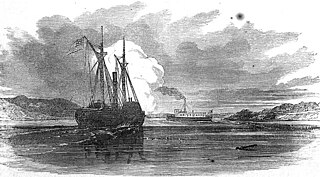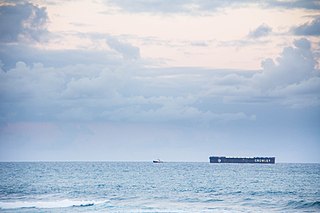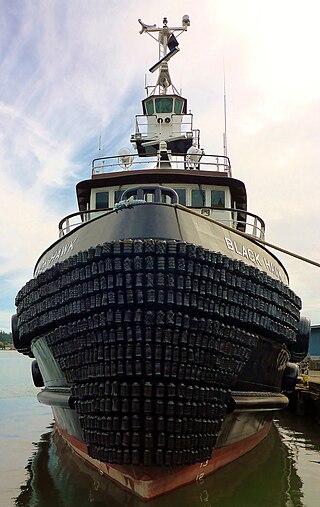
A tugboat or tug is a marine vessel that manoeuvres other vessels by pushing or pulling them, with direct contact or a tow line. These boats typically tug ships in circumstances where they cannot or should not move under their own power, such as in crowded harbors or narrow canals, or cannot move at all, such as barges, disabled ships, log rafts, or oil platforms. Some are ocean-going, and some are icebreakers or salvage tugs. Early models were powered by steam engines, which were later superseded by diesel engines. Many have deluge gun water jets, which help in firefighting, especially in harbours.

Anchor Handling Tug Supply (AHTS) vessels are mainly built to handle anchors for oil rigs, tow them to location, and use them to secure the rigs in place. AHTS vessels sometimes also serve as Emergency Response and Rescue Vessels (ERRVs) and as supply transports.

A salvage tug, also known historically as a wrecking tug, is a specialized type of tugboat that is used to rescue ships that are in distress or in danger of sinking, or to salvage ships that have already sunk or run aground.

USS Grapple (ARS-53) is a Safeguard-class rescue and salvage ship in the United States Navy. Her home port is Norfolk, Virginia. On 13 July 2006 Grapple was decommissioned from US Navy service and converted to civilian operation by Military Sealift Command. She was redesignated as USNS Grapple.

Crowley, legally Crowley Maritime Corporation, is based in Jacksonville, Florida, United States. Founded in 1892, Crowley is primarily a family- and employee-owned vessel management, owner, and supply chain logistics services company, providing services globally. As of July 2016, Crowley was ranked as the 13th largest private company in Florida, employing approximately 5,300 people worldwide with revenues of $2.2 billion. It provides its services using a fleet of more than 300 vessels, consisting of RO-RO vessels, LO-LO vessels, tankers, Articulated Tug-Barges (ATBs), tugs and barges. Crowley's land-based facilities and equipment include terminals, warehouses, tank farms, and specialized vehicles.

The Eisvogel class icebreakers was a two ship class built for the German Navy by the Hitzler Werft shipyard of Lauenburg/Elbe.
Bollard pull is a conventional measure of the pulling power of a watercraft. It is defined as the force exerted by a vessel under full power, on a shore-mounted bollard through a tow-line, commonly measured in a practical test under test conditions that include calm water, no tide, level trim, and sufficient depth and side clearance for a free propeller stream. Like the horsepower or mileage rating of a car, it is a convenient but idealized number that must be adjusted for operating conditions that differ from the test. The bollard pull of a vessel may be reported as two numbers, the static or maximum bollard pull – the highest force measured – and the steady or continuous bollard pull, the average of measurements over an interval of, for example, 10 minutes. An equivalent measurement on land is known as drawbar pull, or tractive force, which is used to measure the total horizontal force generated by a locomotive, a piece of heavy machinery such as a tractor, or a truck,, which is utilized to move a load.

The Ville-class tug are a class of harbour tugboats employed by the Royal Canadian Navy.

The Glen-class tug is a class of naval tugboat operated by the Royal Canadian Navy. Constructed in Canada, the class entered service between 1975 and 1977. The five vessels that comprise the class are split between the two major naval bases of the Royal Canadian Navy. The Royal Canadian Navy operated a fleet of tugboats during the Second World War which were also named the Glen class. The vessels of the current Glen class are each named after one of the vessels of the earlier class.

The MV Solo was a Greenpeace ship from 1990 to 1995, originally built in 1977 as an ocean tug called the Smit Houston. Greenpeace updated the ship with a helipad as well as veterinary and laboratory facilities. In 1995 she was chartered by a company working with the Dutch Ministry of Transport, Public Works and Water Management for use as a salvage vessel. At this time the ship was renamed as the ETV Waker. On 7 September 2009, a fire starting in the engine room so seriously damaged the vessel that she was scrapped.
Icebreaker Eisvogel is an icebreaker employed by the Port of Vienna, Austria. Eisvogel clears ice in all three of Vienna's harbors. She is employed when the ice becomes a few centimetres in thickness. In 1985 she cleared ice that was 60 centimetres (24 in) thick.

The Powhatan class of fleet ocean tugs consists of seven ships built for the United States Navy, and operated by the Military Sealift Command (MSC). The lead ship of the class was launched in 1978 and the last ship in MSC service will be deactivated in 2023. During their service life, the Powhatan's were the most powerful tugs owned by the Navy.
Herakles was a pusher vessel owned by Finnish towing and marine salvage company Alfons Håkans Oy Ab. The ship, originally built as salvage tug Into in 1967, was converted to a pusher in 1991 to be chartered to Rautaruukki Oyj and later ESL Shipping Ltd as the third pusher vessel for the Finnpusku system, a Finnish integrated tug and barge system built in the mid-80s.

The Baltic is a German emergency tow vessel (ETV) commissioned in 2010.

The Nordic is a German emergency tow vessel (ETV) stationed on an offshore position north of the East Frisian island of Norderney on halfway to Heligoland. It is the most powerful tugboat in German waters, operated by Fairplay Towage Group.

The Sovereign is a large sea-going tugboat owned and operated by Royal Boskalis Westminster N.V.

The United Kingdom's emergency towing vessel fleet were a maintained fleet of emergency tow vessels (ETV) from 1993 through 2011. The vessels were privately owned and operated for Her Majesty's Coastguard. Four vessels were stationed around the UK coastline, while a fifth was held in reserve.

Sause Bros., Inc., a pioneering Oregon ocean towing company founded in 1936, is a privately held, fourth-generation family company serving routes along the West Coast of the United States, Hawaii and other islands of the South Pacific, as well as Alaska. It maintains a sixty-vessel fleet of tugboats and barges, employing approximately 400 people at its facilities in Coos Bay, Portland, and Rainier, Oregon; in Long Beach, California; and in Honolulu and Kalaeloa, Hawaii.
Asterix was a small tug/mooring launch which capsized and was a total loss in March 2015 while operating at the marine terminal of Fawley Refinery in Southampton Water, England
The S.A. John Ross along with her sister ship S.A. Wolraad Woltemade, was one of a pair of South African ocean-going salvage tugs built in the late 1970's in order to support passage of redirected traffic around The Cape of Good Hope as a result of the closure of the Suez Canal following the 6-Day War.
























